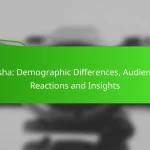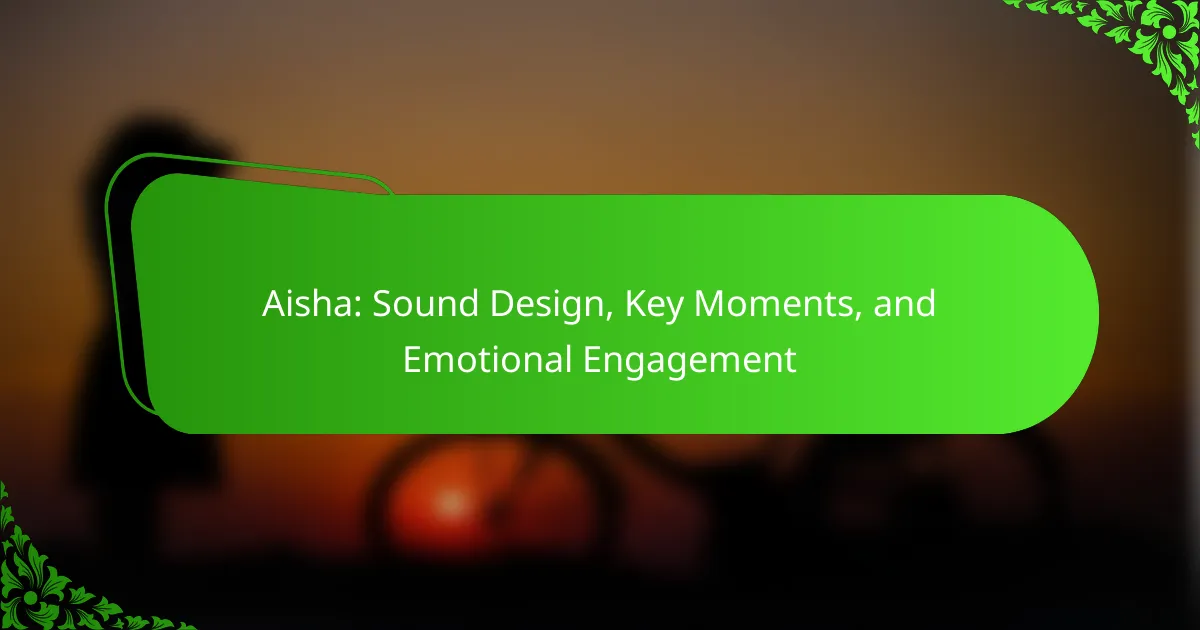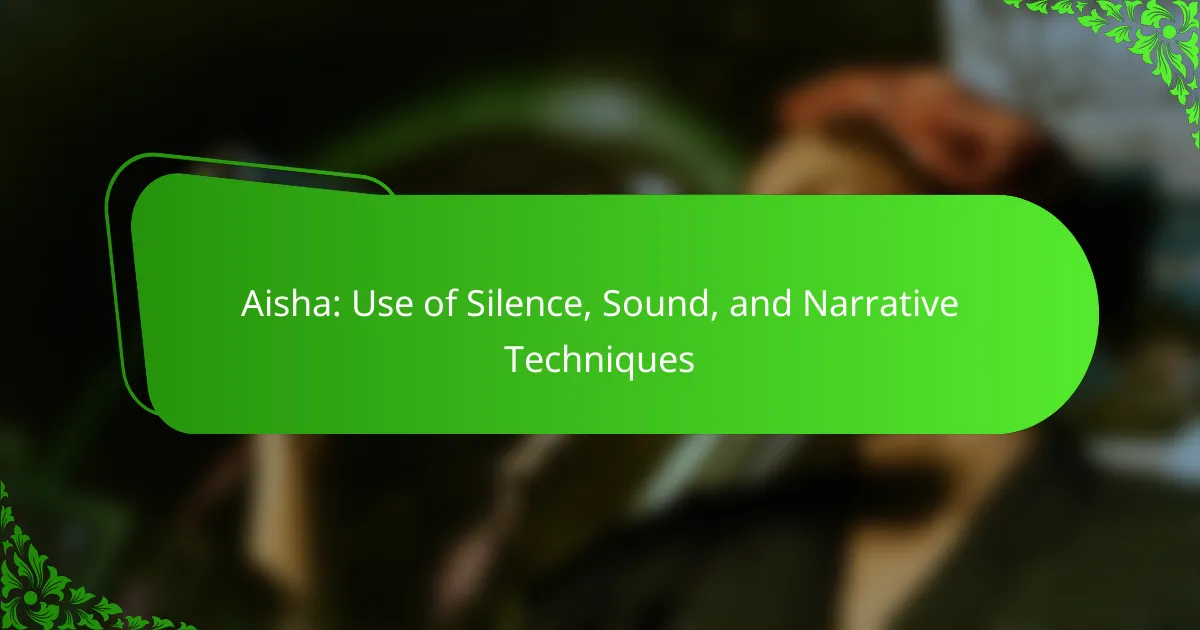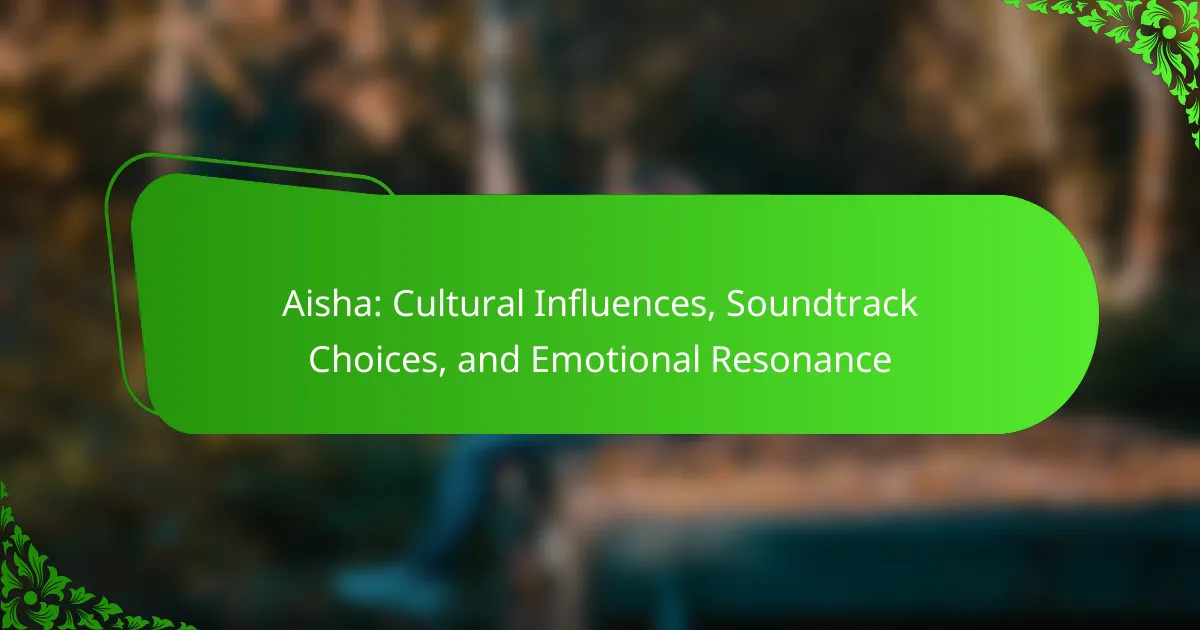Aisha’s expertise in sound design transforms film into an immersive auditory experience, enhancing emotional engagement and narrative depth. By skillfully crafting soundscapes that resonate with audiences, she elevates key moments such as emotional climaxes and action sequences, ensuring that each audio element contributes meaningfully to the storytelling process.

How does Aisha enhance sound design in film?
Aisha enhances sound design in film by creating immersive audio experiences that deepen emotional engagement and narrative impact. Through innovative techniques, she crafts soundscapes that resonate with audiences, making the film’s environment feel authentic and alive.
Innovative soundscapes
Aisha’s approach to innovative soundscapes involves blending various audio elements to create a rich auditory experience. This can include the use of ambient sounds, musical scores, and sound effects that complement the visual storytelling. For instance, layering sounds from nature with subtle musical undertones can evoke specific emotions and enhance the viewer’s connection to the scene.
To achieve effective soundscapes, consider the emotional tone of each scene and select sounds that align with that mood. Experimenting with different combinations can lead to unique auditory experiences that captivate the audience.
Layered audio techniques
Layered audio techniques are essential in Aisha’s sound design, allowing for a more complex and engaging listening experience. By combining multiple audio tracks, she can create depth and texture in the sound, making it feel more realistic. For example, layering dialogue with background sounds and music can help to establish a sense of place and time.
When using layered audio, it’s crucial to maintain clarity. Ensure that the primary audio elements, such as dialogue, are not overshadowed by background sounds. A good rule of thumb is to keep background noise at a lower volume, allowing the main elements to shine through.
Realistic environmental sounds
Realistic environmental sounds play a vital role in Aisha’s sound design, as they ground the film in a believable context. These sounds can range from urban noise to natural wildlife, depending on the setting of the film. For instance, incorporating the sound of rustling leaves or distant traffic can transport the audience into the film’s world.
To effectively integrate environmental sounds, consider the geographical and cultural context of the film. Using region-specific sounds can enhance authenticity and make the viewing experience more relatable. Additionally, pay attention to the volume and placement of these sounds in the mix to ensure they complement rather than distract from the main narrative elements.
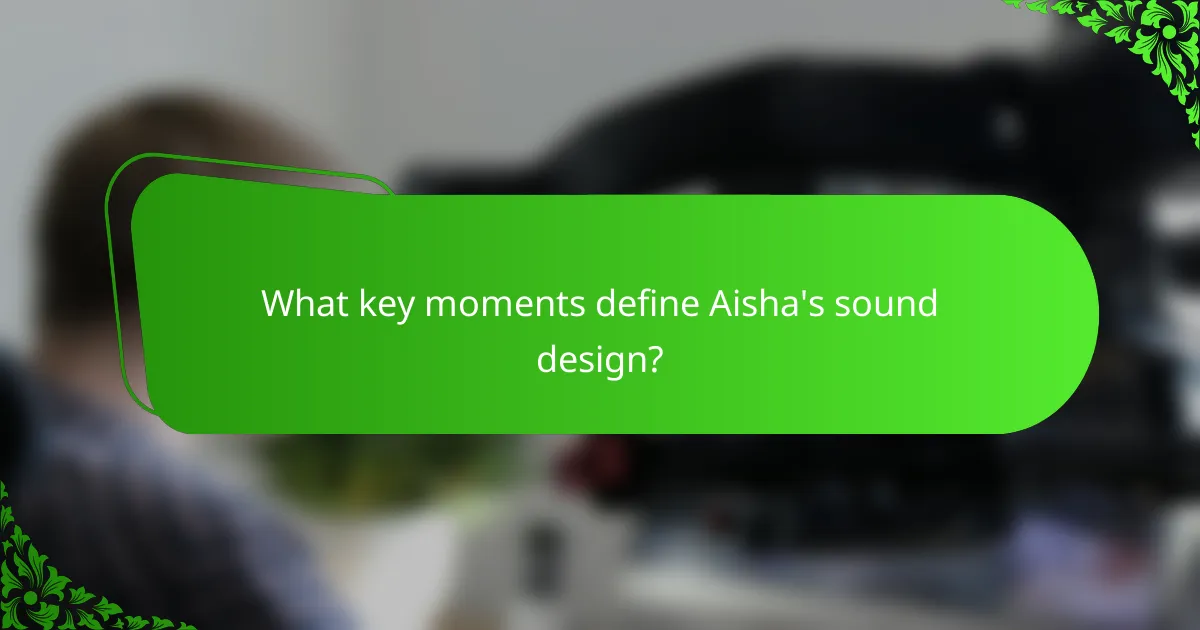
What key moments define Aisha’s sound design?
Aisha’s sound design is defined by its ability to enhance storytelling through carefully crafted audio elements that resonate with the audience. Key moments include emotional climaxes, character development scenes, and action sequences, each utilizing sound to deepen engagement and convey meaning.
Emotional climaxes
Emotional climaxes in Aisha are marked by a significant shift in sound, often using crescendos and harmonies to amplify the intensity of the moment. For instance, a sudden swell of strings or a poignant piano melody can evoke feelings of joy or sorrow, drawing the audience deeper into the narrative. The timing of these sound elements is crucial, typically aligning with visual cues to maximize impact.
To effectively design sound for emotional climaxes, consider the use of silence before a key moment to create tension, followed by a powerful auditory release. This technique can heighten the emotional response and make the climax more memorable.
Character development scenes
In character development scenes, sound design plays a pivotal role in illustrating a character’s internal journey. Subtle background sounds or thematic motifs can reflect a character’s emotional state, such as a soft, melancholic tune accompanying moments of introspection. This auditory backdrop helps the audience connect with the character on a deeper level.
Utilizing sound effects that mirror a character’s environment can also enhance these scenes. For example, the sound of rain can signify a character’s sadness, while lively street sounds might indicate a moment of joy or freedom. This alignment of sound with character emotion is essential for effective storytelling.
Action sequences
Action sequences in Aisha are characterized by dynamic sound design that complements fast-paced visuals. The use of sharp sound effects, such as gunfire or explosions, combined with an energetic score, creates a thrilling atmosphere that keeps viewers engaged. Layering multiple sound elements can add depth, making the action feel more immersive.
To optimize sound design in action scenes, ensure that the audio matches the intensity of the visuals. For instance, increasing the volume and tempo of the music during high-stakes moments can elevate excitement. Additionally, consider the spatial placement of sounds to create a three-dimensional experience, allowing the audience to feel as if they are part of the action.
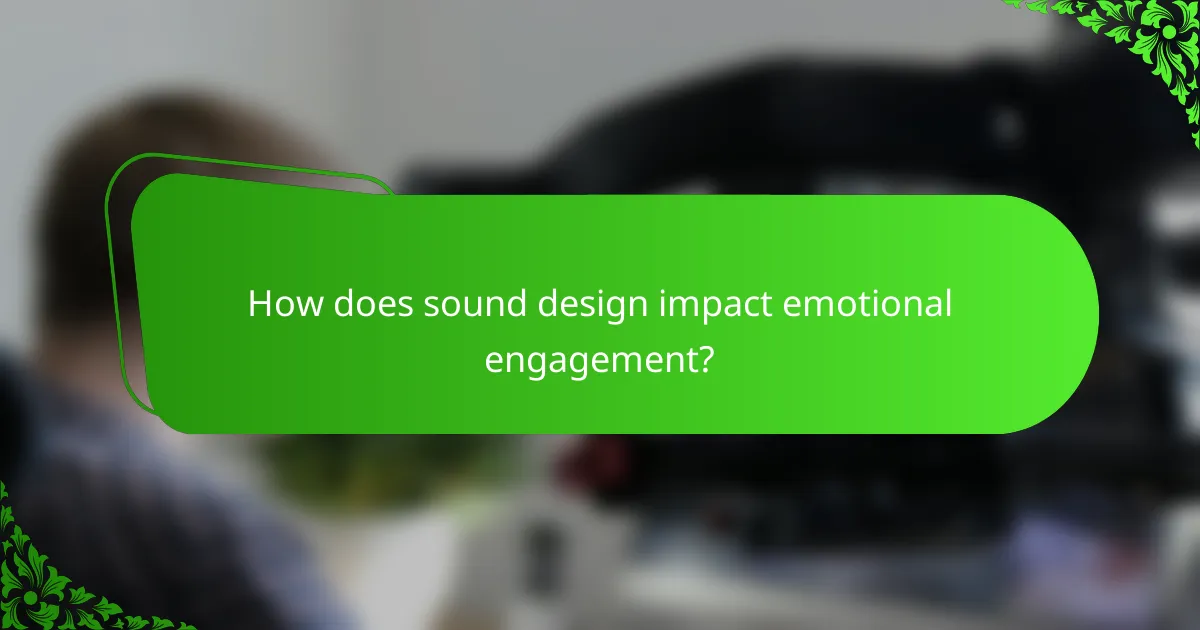
How does sound design impact emotional engagement?
Sound design significantly enhances emotional engagement by creating an immersive experience that resonates with the audience. It shapes the mood and atmosphere, guiding viewers’ feelings and reactions throughout a narrative.
Heightened audience immersion
Effective sound design draws the audience deeper into the story, making them feel as if they are part of the action. By using ambient sounds, spatial audio, and dynamic soundscapes, creators can create a rich auditory environment that complements the visuals.
For instance, in a tense scene, the use of low-frequency rumbles or sudden sharp sounds can elevate the suspense, making viewers more invested in the outcome. This technique is particularly effective in genres like horror or thriller, where sound can amplify fear and anticipation.
Subtle emotional cues
Sound design provides subtle emotional cues that can influence how the audience perceives characters and events. Music, in particular, can evoke specific feelings, such as joy, sadness, or nostalgia, often without the audience being fully aware of it.
For example, a soft piano melody might accompany a heartfelt moment, subtly guiding viewers to feel empathy for the characters. This emotional layering enhances storytelling, allowing for a more profound connection between the audience and the narrative.
Memorable auditory motifs
Creating memorable auditory motifs helps reinforce themes and character identities within a story. These motifs can be simple musical phrases or distinctive sound effects associated with specific characters or situations.
For instance, a recurring sound associated with a character can evoke their presence even when they are not on screen, maintaining emotional continuity. This technique is often used in film and television to create a lasting impression and deepen the audience’s emotional investment.
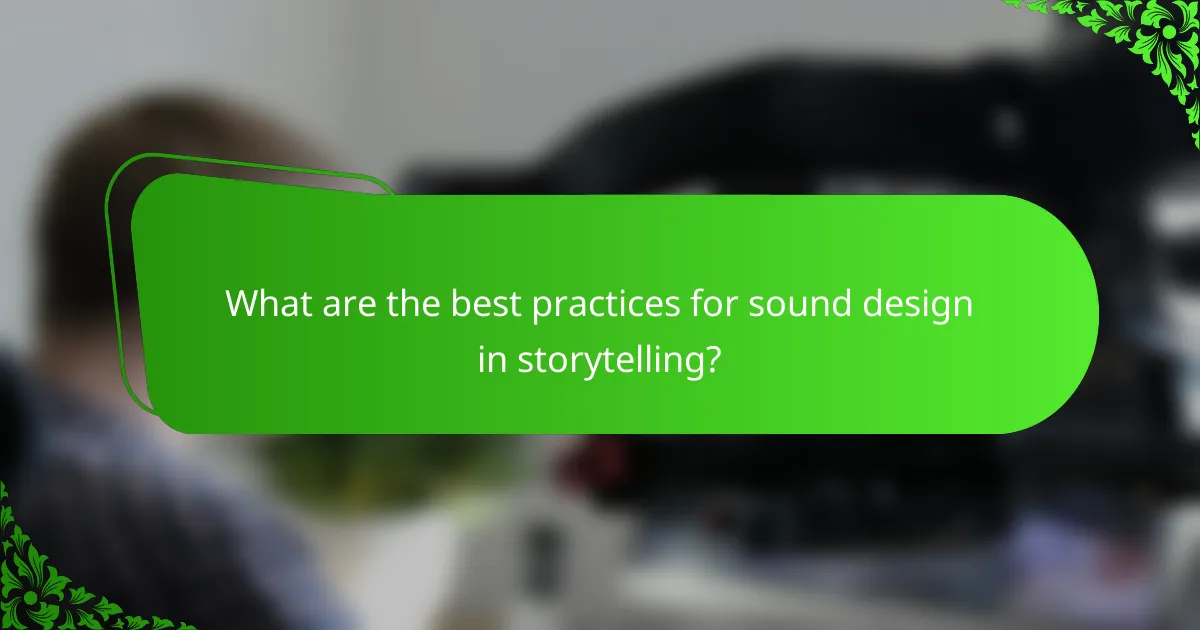
What are the best practices for sound design in storytelling?
Effective sound design in storytelling enhances the narrative by creating an immersive experience that resonates emotionally with the audience. Key practices include establishing thematic consistency, balancing dialogue with sound effects, and using sound to reinforce key moments.
Creating thematic consistency
Thematic consistency in sound design involves using audio elements that align with the story’s mood and themes. This can include specific musical motifs or sound effects that recur throughout the narrative, helping to establish a recognizable auditory identity.
For example, a suspenseful thriller might employ low, rumbling sounds to evoke tension, while a romantic story could use soft, melodic tunes to enhance emotional moments. Consistency in sound helps the audience connect more deeply with the characters and their journeys.
Balancing dialogue and effects
Balancing dialogue and sound effects is crucial for clarity and engagement. Dialogue should always be intelligible, while sound effects should complement rather than overpower the spoken words. A good rule of thumb is to keep sound effects at a lower volume during dialogue-heavy scenes.
Consider using dynamic range techniques, where the volume of sound effects is adjusted based on the intensity of the dialogue. For instance, in an action scene, sound effects can be more pronounced, but they should still allow the audience to follow the characters’ conversations without strain.

What tools does Aisha use for sound design?
Aisha utilizes a variety of sound design tools that enhance her creative process and emotional engagement in her projects. The primary tools include Ableton Live, Pro Tools, and Soundly, each offering unique features that cater to different aspects of sound design.
Ableton Live
Ableton Live is a versatile digital audio workstation (DAW) favored for its intuitive interface and powerful capabilities. It excels in live performance settings and allows for seamless integration of MIDI and audio tracks, making it ideal for sound design and music production.
Key features include a robust session view for improvisation and a wide range of built-in effects and instruments. Aisha often uses Ableton Live to create soundscapes and manipulate audio samples quickly, enhancing her projects’ emotional depth.
Pro Tools
Pro Tools is a professional-grade audio editing software widely used in the film and music industries. It offers advanced editing capabilities and high-quality audio processing, making it suitable for detailed sound design work.
Aisha leverages Pro Tools for its precision in audio editing and mixing, allowing her to achieve a polished final product. Its compatibility with various plugins also enables her to expand her sound palette, ensuring her designs resonate emotionally with the audience.
Soundly
Soundly is a cloud-based sound library and management tool that provides access to a vast collection of sound effects. It simplifies the process of finding and organizing audio assets, which is crucial for efficient sound design.
Aisha uses Soundly to quickly search for specific sound effects and integrate them into her projects. The platform’s collaborative features also allow her to share sounds with her team, streamlining the workflow and enhancing the overall creative process.
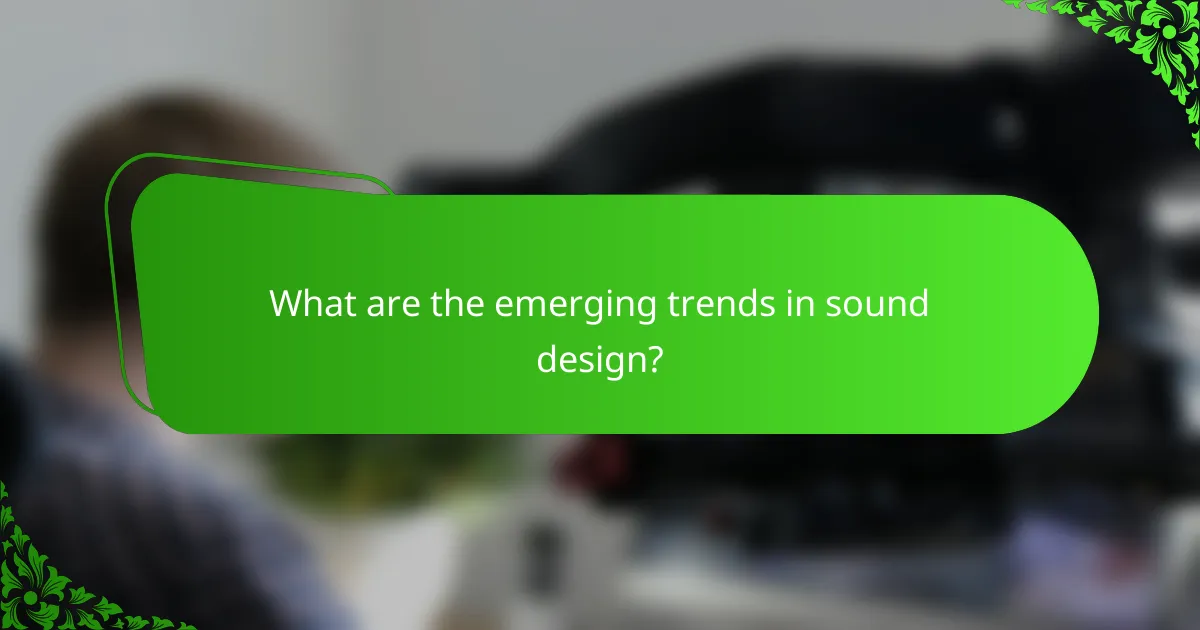
What are the emerging trends in sound design?
Emerging trends in sound design focus on immersive audio experiences, the integration of artificial intelligence, and the use of spatial sound techniques. These trends enhance emotional engagement and create more dynamic environments in various media, from film to gaming.
Immersive audio experiences
Immersive audio experiences utilize advanced technologies like Dolby Atmos and binaural sound to create a three-dimensional sound environment. This approach allows listeners to feel as if they are inside the audio landscape, enhancing emotional connections to the content. For instance, in gaming, players can hear sounds coming from all directions, making the experience more engaging.
Integration of artificial intelligence
Artificial intelligence is increasingly being used in sound design to automate processes, analyze audio data, and even generate soundscapes. AI tools can assist sound designers by suggesting sound effects or optimizing audio levels based on the content’s emotional tone. This technology can save time and enhance creativity, allowing designers to focus more on storytelling.
Use of spatial sound techniques
Spatial sound techniques involve the arrangement of audio elements in a three-dimensional space, providing a more realistic listening experience. This method is particularly effective in virtual reality (VR) and augmented reality (AR) applications, where sound plays a crucial role in user immersion. By placing sounds accurately within the environment, creators can guide users’ attention and evoke specific emotions.


